Mizuya Dogu
The mizu-ya, 水屋, water-house, is a room where preparations are made for presenting Cha-no-yu, 茶の湯, Tea-’s-hot water. Mizu-ya dō-gu, 水屋道具, water-house way-tool, are a large number of utensils used in the actual presentation of ten-mae, 点前, offer-fore. Although some cooking may be done in the mizuya, most of that is done in the kitchen which in Japanese is dai-dokoro, 台所, stand-place, and chū-bō, 厨房, kitchen-room.
The mizuya must have water and a heat source for hot water, and these are provided by a mizu-game, 水瓶, water-vat, and a gan-ro, 丸炉, round-hearth, in the floor. Preparation is called jun-bi, 準備, proportion-prepare.
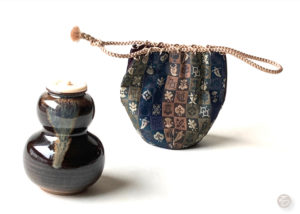
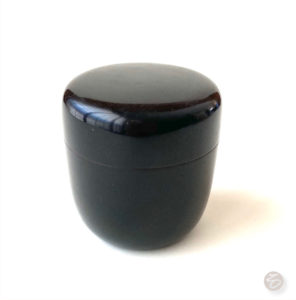
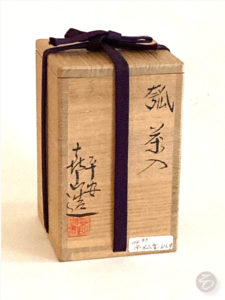
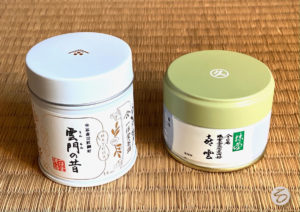
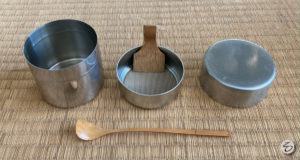
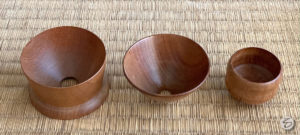
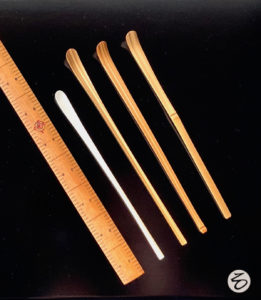

The cup of the ladle is made in the manner of mage-mono, 曲物, bend-thing. The number six is symbolic of infinity in time. In the past, the mizuya had no running water, so that water had to be brought to the mizuya in buckets, oke, 桶, or some kind of transportation. Water to be used at a Tea gathering would be obtained at one of the countless wells. Quite often a home or an institution would have one or more wells depending on the size of the property. Some wells are famous for their fine water which is called mei-sui, 名水, name-water.
The Kanji for mizu-game is also read sui-byō, as it is referred to when adorning the crown of Seishi Bosatsu. Perhaps the guardian of the mizuya is Sei-shi Bo-satsu, 勢至菩薩, Strength-attain Sacred tree-buddha. The yojōhan chashitsu, 四畳半茶室, four-mat-half Tea-room, may represent the Amida San-zon, 阿弥陀三尊, Amida Three-lords. Amida is located in the center and is identified with and is the guardian of the Tea utensils and presentation area, and Kannon Bosatsu is the identified with and is the guardian of the tokonoma and guest area.

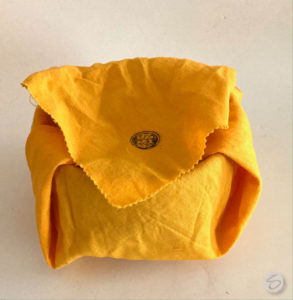
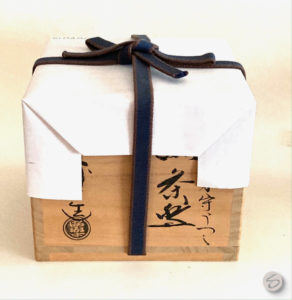
The turmeric dye repels insects. If there is an artist’s stamp on the fabric, the fabric should be folded around the object so that the stamp shows on the top. Many objects are wrapped in such cloths when put into storage boxes. Ideally, the identification and name of the artist are written on the front of the box. The paper cover is for added protection and for more details regarding the contents of the box.
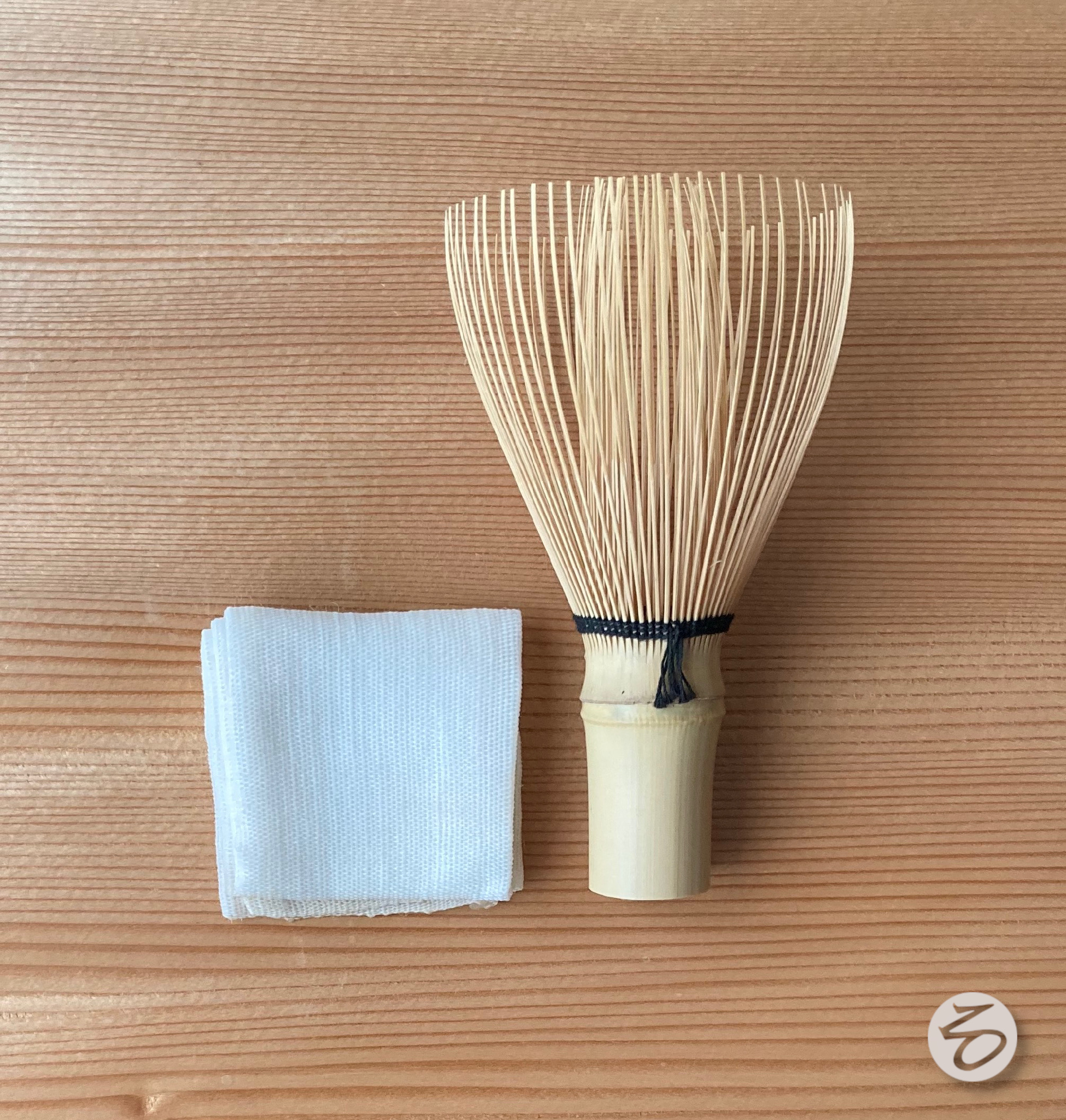
The pictured cha-kin, 茶巾, tea-cloth, is folded five times in the usual manner to wipe a teabowl or other utensil, and measures 15 bu kane-jaku. The cha-sen, 茶筅, tea-whisk, measures 3 sun kujira-jaku. The distance between the thread of the chasen and the bottom is 12 bu kujira-jaku, which is equal to 15 bu kane-jaku, the size of the folded chakin. The distance from the chasen thread to the top is 18 bu kujira-jaku. The number 18 is symbolic of life.
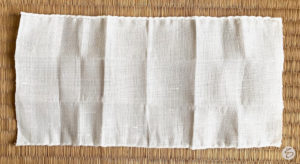
The cloth has its selvage on both sides, and is hemmed in opposite directions on the cut edges. Measurements for weaving are made with kujira-jaku, 鯨尺, whale-span, so that the size of the chakin is 8 x 4 sun kujira-jaku. When the chakin is folded in half to form a square, because of its usual folding, each half is a square composed of nine squares, which may evoke the design of the Kon-gō-kai Man-da-ra, 金剛界曼荼羅, Gold-strength-world Wide-weed-spread.
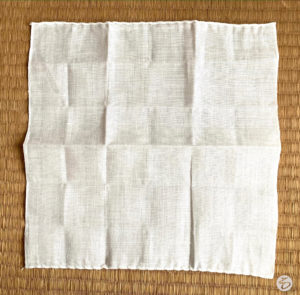
This chakin is used in very formal Tea presentations. When the chakin is un-folded, the fabric retains the folds and creates four squares, each composed of nine squares. The pattern of squares may evoke Buddhist mandalas, the Kon-gō-kai Man-da-ra, 金剛界曼荼羅, Gold-strong-world Wide-weed-spread, and the nine half-mat tatami pattern of a yo-jō-han, 四畳半, four-mat-half.
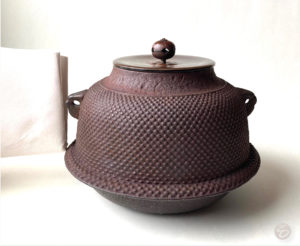
The pack of folded papers, kami kama-shiki, 紙釜敷, paper kettle-rest, has a length of 5.5 sun kane-jaku, that is approximately the same measurement as the full height of the kama in including the knob of its lid. The diameter of the kama including the curved flange, hane, 羽, wing, is 5.5 sun kujira-jaku. The 5.5 sun kane-jaku of the kami kama-shiki relates to the 5.5 sun kujira-jaku diameter of the kama, 8 to 10, which manifests the ya-ta, 八咫, eight-span, similar to the sacred Shintō ya-ta-kagami, 八咫鏡, eight-span mirror, that is symbolic of infinite vastness.

The mizu-ya kan, 水屋鐶, water-house metal rings, are essential utensils, because they move the kama, 釜, kettle. The kan are made of various metals including the common hagane, 鋼, steel, or tetsu, 鉄, iron. The standard mizu-ya
kan, 水屋鐶, water-room metal rings, are used by the host generally outside the view of the guests. These are made of brass, shin-chū, 真鍮, true-brass. The outside diameter of the ring is 2.7 sun kane-jaku. The space between the inside of the over-lapping ends is .4 sun kane-jaku. Were the metal ring to be un-curled and straightened out, the length of the metal rod is 9.5 sun kane-jaku. This is the same length as the standard hi-bashi, 火箸, fire-rods.
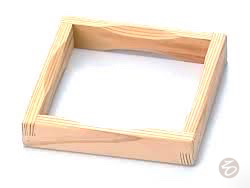
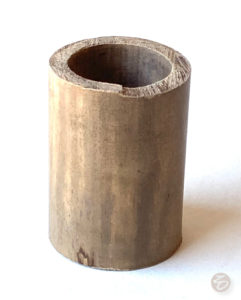
Kama-sue, 釜据, kettle-set; sugi, 杉, cedar, 5.2 sun kane-jaku square: used to support the kama when filling and emptying it in the mizuya. The pieces of wood are 9 x 4 bu kane-jaku. Note that corners overlap rather than being mitered. The structure design suggests movement with the direction of the wood grain. This creates a kind of swastika, man–ji, 卍, which is symbolic of the turning of the universe. The inner edges of the frame are planed away to settle the round bottom of the kama. Cleaning the kama is called cha-gama arai, 茶釜洗い, tea-kettle rinse. The kama-sue is placed on the su-no-ko, 簀の子, reed-’s-of, which is the bamboo pole grate laid over the drain in the floor of the mizuya. After use, the bottom of the kama is scrubbed with a brush, kiri-wara, 切藁, cut-grass, to remove smoke and ash. A kama should be dried quickly over a low fire so that it does not become subject to rusting. The wet kama-sue is a complement to the dry ita kama-shiki, which are aspects of In and Yō.
The pictured futaoki, in the many years since it was made and used, it has not been used in the Tearoom, but occasionally is used in the mizuya. Some may regard it as beautiful in its age and not very skillful cutting, and it might be featured in an October Tea presentation reflecting the decline of autumn. There is a curious aspect to this futaoki as the bamboo has not split, which happens too often for bamboo objects, especially those that get wet. The ao-dake futaoki that is to be used in a Tea presentation, should be kept wet before it is used, so that is remains fresh and green, rather like a cut flower. It is a living thing. According to some traditions, the green bamboo futaoki was to be used only once in a Tea presentation. This is an aspect of wabi, 侘び, and sabi, 寂. The Kanji for sabi is also read jaku, which is one of Rikyū’s four precepts of Chanoyu.
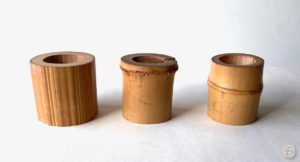
The location of the fushi establishes the name of the utensil, but it is also a manifestation of the relationship between eight and ten. The height of the fushi of the ten-bushi is 8/10th the height of the lidrest. The height of the fushi of the naka-bushi is 10 bu, the distance between the fushi and the top is 8 bu. The top relates to the bottom 8 to 10, which may represent ya-ta, 八咫, eight-span, like the ya-ta kagami, 八咫鏡, eight-span mirror, that is symbolic of infinite vastness.
Take futa-oki, 竹蓋置, bamboo lid-rest; fuki-nuki, 吹抜, blow-through, h. 1.8 sun kane-jaku. It is necessary to have a futaoki in the mizuya to support the lid when removed from the kama. As it is simply utilitarian, one that is used was probably green, and has turned color with age. It is best to use a futaoki that has no special attachment or identity. The bamboo fuki-nuki futaoki above, I cut the futaoki from green bamboo that was growing near a friend’s house outside of Kyōto. It was used in a Tea for friends.
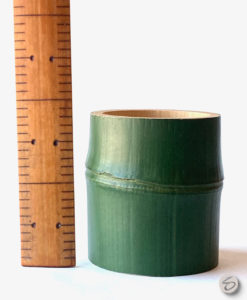
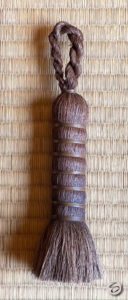
More formally called shu-ro-bōki, 棕櫚箒, hemp-quince brush, the bundle of fibers of the hemp palm is bound with copper wire that is used to scrub the bottom of the kama after being taken from the charcoal fire in the hearth: cha-gama arai, 茶釜洗い, tea-kettle rinse. The form of the brush is called tsuri-gane gata, 釣鐘型, suspend-bell shape. In Japan, there are many objects made with this useful and sturdy material. The space between the wrapped copper wire, is equal to a tatami me. The bell to which it is likened is a temple bon-shō, 梵鐘, buddhism-bell.
Kama-shiki, 釜敷, kettle-spread: measurements given in kane-jaku, 曲尺, bend-span.
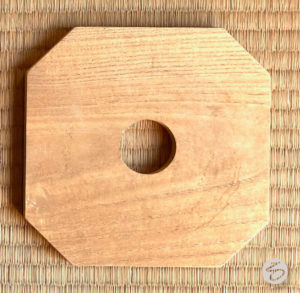
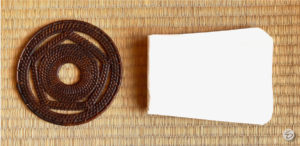
In fact, the ita and kumi kama-shiki were intended to support a kama, but the kami kamashiki, which was the original kaishi, is a substitute for the kumi kamashiki. Once, its use may have been a spontaneous replacement taken from the front of the kimono of the host when presenting the charcoal fire in the presence of the guests.
In the presence of the guests in the tearoom, Urasenke uses the kami kama-shiki when presenting sho-zumi, 初炭, first-charcoal, and the kumi kama-shiki when presenting go-zumi, 後炭, latter-charcoal. The ita kama-shiki is used to tend to the charcoal fire before the guests arrive in the Tearoom, as well as in the presence of the guests without a prescribed manner of presentation. Although the kama-sue in the mizuya is similar in function to the kama-shiki, it is not brought into the Tearoom. The wet kama-sue complements the dry ita kama-shiki: In and Yō.
The hole in the ita kamashiki, is one sun kujira-jaku, so that it can be slipped over the upright handle support on a hako sumi-tori, 箱炭斗, box charcoal-measure, that is for the most part kept in the mizuya but is at times brought into the Tearoom to tend to the charcoal fire.
The kami kama-shiki is held in high regard as it is frequently used to support a kōgō displayed in the tokonoma. Their connection is based in building the charcoal fire in the presence of guests, when the incense is put into the fire after the charcoal has been placed. Incense is essential in the offerings to the Buddha. The spiritual aspect of the incense may suggest that the pack of fine papers has some spiritual aspects as well.


The measurements are in kane-jaku, 曲尺, bend-span, which seem to have a secret connection between the two objects. The kama-sue is 5.2 sun square. The octagonal board has two measurements: 5.7 and 6.5 sun kane-jaku, although they are irrelevant when compared to the possible relationship with the kama–sue. The similarities are the perimeters of both pieces. The perimeter of the kama-sue is 20.8 sun kane-jaku. The perimeter of the octagon is composed of the long edge 3.5 sun kane-jaku and the short edge 1.6 sun kane-jaku, and when added together they equal 5.1 times 4 equals 20.4 sun kane-jaku. The two measurements are almost identical. There may be a slight error in the manufacturing of the pieces, and in truth the two measurements should be identical.

The kami kama-shiki that is displayed in the tokonoma along with the kōgō is very often of superior quality when compared with the papers used when building the charcoal fire. The finest paper is called dan-shi, 檀紙, sandalwood-paper.
The kō-gō, 香合, incense-gather, is a black-lacquered square, covered box with an inlaid design of three partial chrysanthemums and edges trimmed with geometric patterns in ao-gai, 青貝, blue-shell. This type of kōgō is appropriate for use with the furo and would contain pieces of byaku-dan, 白檀, white-sandalwood.
Danshi is made from the bark fibers of kōzu, 楮, a kind of paper mulberry wood. The crepe-like appearance of the paper is likened to the split grain of sandalwood. It should be known that in Buddhism, the ideal incense is byaku-dan. In its way, the danshi paper is identified with the incense in the kōgō. The number of sheets of paper of the display kami kamashiki is fifteen, which when doubled is thirty. There are thirty chapters of the in the Heart Sutra. The Kanji for dan, 檀, sandalwood, is composed of tree, 木, and truly, 亶, which is also part of the Kanji for altar, dan, 壇.



Pieces of byakudan used in Chanoyu are approximately 5 bu kane-jaku square, and are kept in a small wooden box in the mizuya; with commercial paper kō-tsutsumi, 香包, incense-wrapper. Byakudan is used with fu-ro, 風炉, wind-hearth, according to the tradition of Sen no Rikyū, and three pieces are held in a covered lacquered container.
Nerikō is a blend of aromatics and charcoal dust held together with honey. The dense paste is formed into small balls approximately 2 bu kujira-jaku. This method is typical of traditional Asian medicines. As it is a blend of ingredients, fragrances differ greatly, and poetic names are given to specific blends. According to Sen no Rikyū, nerikō is used with the ro, 炉, (sunken) hearth. When building the charcoal fire in the presence of the guests, a piece of nerikō is held in a ceramic container. Nerikō is formed into a shi-men-tai, 四面体, four-side-body, tetrahedron, that measures .24 bu kujira-jaku. Because it is wet, nerikō should be kept in an air-tight container. Nerikō is available widely, and is sold in various kinds of containers: pictured are a ceramic, covered jar, and a plastic bag
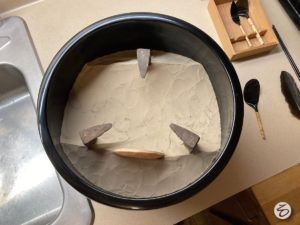
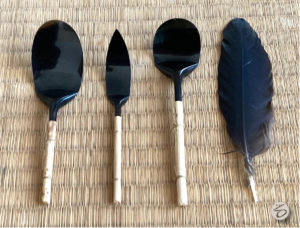
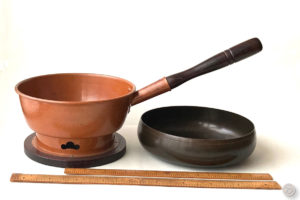
Daijūnō base, 6 sun kane-jaku or 5 sun kujira-jaku. The full diameter of the tarai is 6 sun kane-jaku or 5 sun kujira-jaku. The daijūnō transports burning charcoal to and from the hearth in the Tearoom. It has wooden base to protect the tatami. The opening in the base is in the form of a pine bough, symbolic of longevity. The tarai is Kara-kane, 唐銅, Tang-copper.
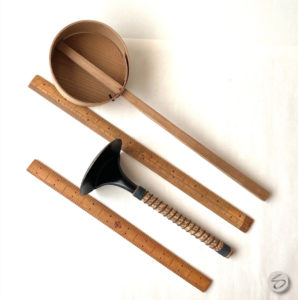
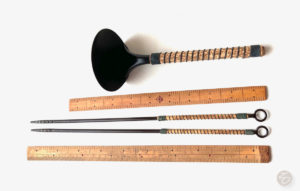
Both of the utensils are made of steel that is blackened, and with handles covered with take-no-kawa, 竹の皮, bamboo-’s-skin, bound in black twine. There are six notches on both sides of the pointed ends of the hibashi to help hold the charcoal. The length of the bamboo skin-bound handles of the hibashi including the ring ends, measures 4 sun kujira-jaku, with 6 sun kujira-jaku of bare steel. The length of the bamboo skin is 4.5 sun kujira-jaku, the length of bare steel including the ring end is 6.5 sun kujira-jaku.
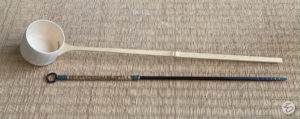

Jinkō wood is cut into squares just as with byaku-dan, 白檀, white-sandalwood, approximately 5 bu kane-jaku. Generically called agarwood, it is rarely ‘burned’ in the furo in the Tearoom, but is part of a procedure of incense presentation called kō-bon, 香盆, incense-tray. The illustrated squares of wood would be cut into tiny pieces, about the size of a half-grain of rice. The incense is not actually burned, but heated on a sheet of mica placed over a piece of burning charcoal in an incense burner. This type of exotic fragrant wood, which is closely associated with Buddhism, can be exceedingly expensive, and is becoming more difficult to obtain. There are several kinds of jinkō called by names that often indicate their geographical origin. The most celebrated jinkō is called kyara, 伽羅, attend-spread.

Various tools are needed to prepare for presentations, and preparations take place in the mizuya. Kōbon is almost directly adopted from Kō-dō, 香道, Incense-way, as is much the procedures and mood of Chanoyu. The appreciation of incense is called mon-kō, 聞香, listen-incense, as one ‘listens’ to incense rather than ‘smells’ it.


The large paper folder, just as the very small incense paper folder, is composed of nine ‘squares’ implying infinity in space. The pictured piece of incense is kyara, 伽羅, attend-spread, a very special kind of jin-kō, 沈香, submerged-incense.
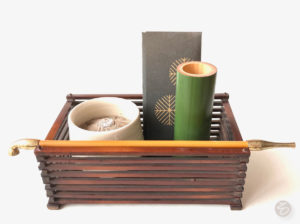
The preparations of the tabako bon take place in the mizuya; igniting the charcoal and adding a small amount of water in the haifuki to extinguish the burning ash tapped from the pipe.
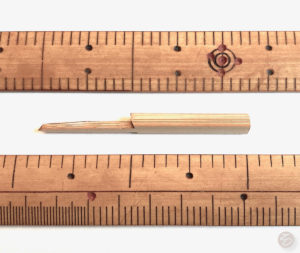
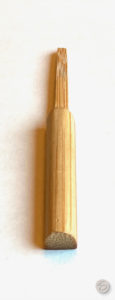
The take-kugi, 竹釘, bamboo-‘nail,’ is used in great prominence, as it is used to hang a scroll in the tokonoma, when it is also called jiku-kugi, 軸釘, scroll-‘nail’ These bamboo ‘nails’ are also present in the mizuya where they are driven into the wall to hold chasen and cloths to dry.
In the tokonoma, the ‘nail’ is driven into the middle of the back wall near the ceiling. As the bamboo would be damaged if struck with a hammer, a hole is drilled 9 bu kane-jaku from the ceiling at a 20° angle, and the bamboo ‘nail’ inserted. The ‘nail’ is set at an angle so that the cord of the scroll will not slip off. The cross-section of the bamboo is a half-round, which could evoke a han–getsu, 半月, half-moon; a ceiling is called ten-jō, 天井, heaven-well. The length of the ‘nail’ is 1.8 sun kujira-jaku, and is divided into two sections. As there is an angle where the two ends meet, measuring is a bit of a challenge. However, the length of the hanging end is one sun kujira-jaku, and the length of the pointed end is one sun kane-jaku or 8 sun kujira-jaku. The ends relate to each other 8 to 10, which is an aspect of ya-ta, 八咫, 8-span, which is symbolic of infinite vastness. The mean number between 8 and 10 is 9.
The spiritual significance of bamboo is due to its hollowness. Buddhists believe that we are like stalks of bamboo and are empty. The Buddha was given a bamboo grove by King Bimbisara of Rajagaha, which was near his palace, and thus provided a place for him and his followers to live in comfort. A monastery was built there. The words bamboo-grove monastery in Sanskrit is venuvana–vihara, and in Japanese, chiku-rin shō-ja, 竹林精舎, bamboo-grove spirit-house. In Japan, a number of Buddhist temples incorporate Chikurin in their names.
